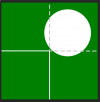shaunsouthern
New Member
Hi
The images below show a football, from above near the corner of the pitch. Law 9 says that "The ball is out of play when: It has wholly crossed the goal line or touch line, whether on the ground or in the air."
Has the ball "wholly crossed the goal line" or "wholly crossed the touch line" ?
If the lines are extended then it hasnt, yet no part of the ball is over any part of the pitch.
Is the ball in or out of play ?
Thanks
Shaun
The images below show a football, from above near the corner of the pitch. Law 9 says that "The ball is out of play when: It has wholly crossed the goal line or touch line, whether on the ground or in the air."
Has the ball "wholly crossed the goal line" or "wholly crossed the touch line" ?
If the lines are extended then it hasnt, yet no part of the ball is over any part of the pitch.
Is the ball in or out of play ?
Thanks
Shaun





